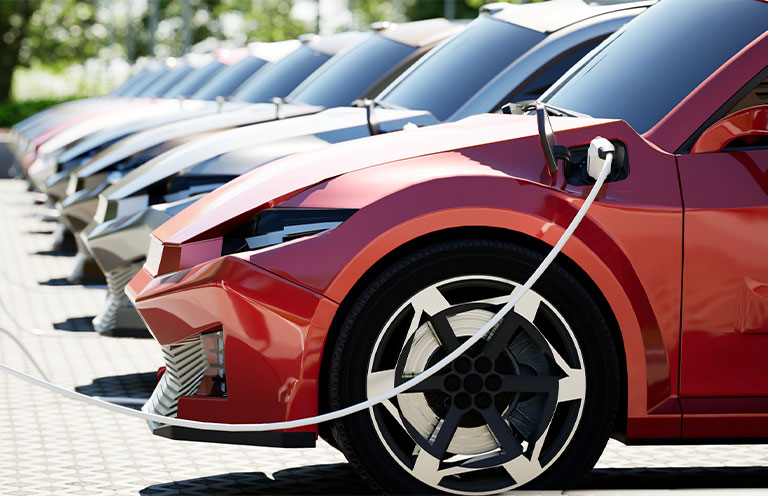4 Auto Industry Trends Drivers Should Know About
Get the inside scoop on electric cars, augmented reality features, autonomous driving, and more


Whether you're in the market for a new or used car now or plan to be soon, it's often helpful to get a feel for where the auto industry is headed by understanding current trends. Doing a bit of homework now can help you leverage predictions on future automotive developments to decide when it's the right time to upgrade your ride. Here are 4 trends drivers should keep on their radar:

1. Electric cars are the future.
In 2020, the International Energy Association (IEA) estimated that global electric vehicle (EV) sales made up 4% of total vehicle sales, while the sales of electric and hybrid vehicles in Europe increased a whopping 137% over the same period. These numbers are even more impressive when you consider that growth took place despite a 20% decrease in sales over the entire vehicle market due to the pandemic.
Europe and China currently lead the charge for EV adoption, but some states like California have pledged that, by 2030, all new passenger cars and light-duty trucks sold must be zero emission. As the charging infrastructure in America improves and battery technology evolves to increase the mileage range per charge, experts expect EV sales to catch up to and eventually surpass their gas-powered counterparts. In fact, Bloomberg announced in early 2024 that the global sales of gasoline-powered vehicles peaked in 2017 and will continue to decline. Like it or not, EVs are here to stay.
2. Autonomous driving features continue to evolve.
The Society of Automotive Engineers (SAE) defined 6 levels of autonomous driving in 2014 as autonomous technology began to pop up in vehicle models. The levels were designed to communicate and classify the driver automation features equipped in a vehicle to specify the amount of control a driver has behind the wheel. Below is a quick chart summarizing the level designations and what they mean:
|
|
|
| Level 0 | No driving automation. Driver maintains full control of all vehicular features and functions while some features like blind spot warning or lane departure detection may provide alerts to keep them aware. |
| Level 1 | Some assistance features are available to support driver inputs, but driver is still maintaining full control. Level 1 features include lane centering and adaptive cruise control technologies. |
| Level 2 | Partial driving automation, but features only support driver, who must still steer, brake, accelerate, and constantly monitor features. Level 2 features include lane centering and adaptive cruise control that works at the same time as lane centering. |
| Level 3 | Conditional driving automation which engages and takes over for the driver, even while they are behind the wheel. Driver must still maintain awareness of vehicle functions with Level 3 features including traffic jam chauffeur. |
| Level 4 | High driving automation features that control the vehicle under limited conditions. Level 4 features include local driverless taxis and pedals or steering wheels are absent, but vehicle will not operate unless a strict set of conditions are met. |
| Level 5 | Full driving automation, which is the same as Level 4, but Level 5 automation can drive a vehicle everywhere in all conditions. |
While Level 1 technologies like blind spot warning systems and emergency braking have become quite commonplace among economy vehicle models, in the coming years, drivers can expect Level 2 and Level 3 autonomy to become more prevalent. Features like autonomous driving in traffic are already available in high-end luxury vehicles like the Mercedes S-Class and Tesla models.
Drivers can expect these features to spread as cameras, radar, and LiDAR become more standardized.

3. Connectivity will become more robust.
The "smartification" of all consumer electronics continues to bring new levels of connectivity between devices each year—and the vehicles we drive are no exception. Drivers are already accustomed to Bluetooth and Wi-Fi features in their vehicles with device integration that provides everything from driving directions to streaming our favorite podcasts.
It's expected that in the coming years, vehicles will soon have the ability to "talk" to other smart vehicles as well as the smart infrastructure around them. As communication with things like traffic signals and other vehicles improves, onboard computers will be able to detect their surroundings better and help prevent collisions, running red lights, and more.
4. Augmented reality will become standard.
As technology continues its march into every facet of our lives, auto manufacturers continue to implement augmented reality (AR) features to improve driver experience and service. Manufacturers like Hyundai, for example, already have an AR manual that allows owners to use their device to identify vehicle components and find out more about how they work.
Additionally, look for more vehicles that project AR information onto windshields (think addresses, driving directions, and speed limits), allowing drivers to process things in real time without taking their eyes off the road.
As the auto industry continues to adapt, drivers can expect the march of technology to continue impacting the experience of buying and owning a vehicle. While it’s always been important to research vehicle purchases since they’re among the most significant investments someone can make, it’s even truer today. By staying on top of industry developments, vehicle owners can make more educated decisions and ensure they’re behind the wheel of a vehicle that fully meets their transportation needs.
